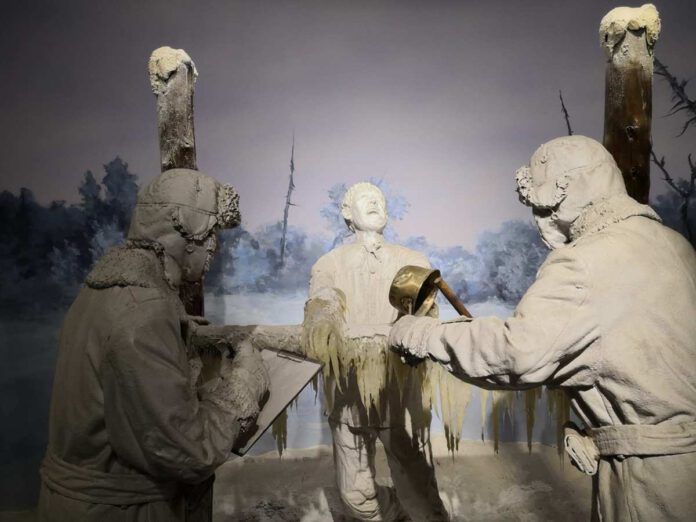
* Amid the joyous festivities at popular spots like the Ice-Snow World theme park, tens of thousands have also flocked to a memorial outside the city center.
* The notorious Unit 731 was a top-secret biological and chemical warfare research base established in Harbin as the nerve center for Japanese biological warfare in China and Southeast Asia during World War II.
* More and more young people are braving the wind and snow to come here and learn about history, demonstrating the strength and responsibility of the younger generation in China.
Since the beginning of the year, Harbin, capital of northeast China’s Heilongjiang Province, has emerged as a top winter destination. But, amid the joyous festivities at popular spots like the Ice-Snow World theme park, tens of thousands have also flocked to a memorial outside the city center.
On a frigid weekday morning, with the temperature in the city dropping to minus 26 degrees Celsius, the spirits of those visiting the Exhibition Hall of Evidence of Crimes Committed by Unit 731 of the Japanese Imperial Army remained undeterred.
Braving the freezing weather, people queued up at the public square outside the exhibition hall. Among the visitors were many young people, some accompanied by their children. Despite the harsh weather, they patiently waited for one or two hours, with volunteers distributing hot water and warming pads to alleviate the cold.
The notorious Unit 731 was a top-secret biological and chemical warfare research base established in Harbin as the nerve center for Japanese biological warfare in China and Southeast Asia during World War II. At least 3,000 people were used for human experiments by Unit 731, and more than 300,000 people in China were killed by Japan’s biological weapons.
This winter the exhibition hall has been ranked third among all other tourist attractions in Harbin by the world’s leading travel platform TripAdvisor.
This exhibition hall showcases documents, experimental utensils and tools used by the Japanese, along with videos that record the accounts of former Unit 731 soldiers.
Xu Xiaomeng and her two friends patiently waited for nearly 30 minutes before gaining entry to the hall. “It is worthwhile because this history should be remembered by every Chinese,” said the 32-year-old Xu, who works as a middle school English teacher in central China’s Hubei Province.
They planned their trip based on recommendations from social media, and the exhibition hall was on their “must-visit” list.
According to Xu, the frozen experiment performed on Chinese victims was the most unsettling aspect of the exhibition. She acknowledged that the curators might have omitted certain graphic details, but the exhibits still startled her.
Her friend Huang Guangjing, who is a Chinese literature teacher, said that she was profoundly dismayed to learn about the germ warfare conducted by Unit 731. “I will share everything with my students to ensure that they carry forward the memory.”
Qian Xiaomin, a 36-year-old resident of Hangzhou, capital city of east China’s Zhejiang Province, said that she and her 12-year-old son had planned to spend a week in Harbin, with the exhibition hall being their first stop.
Following their visit, her son Qian Yanchu decided to document his impressions of the exhibition in his diary. “If I could turn back in time, I would join the army to protect my fellow countrymen,” the boy said, adding that for now he wants to work hard and contribute to the building of a stronger nation.
Numerous children and teenagers, just like Qian, were visiting the exhibition hall. Most of them quietly looked at the exhibits and attentively listened to the descriptions, occasionally posing questions to their parents.
Lin Yanlu, accompanied by her six-year-old son and septuagenarian parents, was among the visitors. She said that her son tried to read the descriptions himself and was petrified by the vivid accounts of vivisection. “Our country has grown stronger, but this transformation came at the cost of many martyrs,” she told her son.
In addition to the exhibition hall, people also flocked to the Northeast China Revolutionary Martyrs’ Memorial Hall, which has welcomed over 65,000 visitors this year, excluding those who joined virtual tours online. Of all the visitors a large percentage are young people, including more than 30,000 from 270 student groups.
Guide Gao Peng, 30, has been working at the Unit 731 exhibition hall for six years. “I always encounter visitors with various questions,” he said. “Through our conversations, my aim is for them to gain a deeper understanding of the historical events from those years, fostering not hatred but rather the courage and motivation to move forward.”
To cope with the surge in visitors, the exhibition hall changed the opening time from 9 a.m. to 8 a.m. starting from late December in 2023, and extended opening hours.
Since the beginning of this year, the daily average number of visitors has continued to surpass 17,000. As of the end of January, the exhibition has welcomed over 500,000 visitors, with approximately 90 percent coming from outside Heilongjiang, and 60 percent being young people.
Meanwhile, discussions about visits to the exhibition hall continued to gain widespread attention on Chinese social media. On Sina Weibo, searches related to these topics surpassed 360 million, and posts tagged with “731” were viewed around 2.6 billion times on Douyin, the Chinese version of TikTok.
“More and more young people are braving the wind and snow to come here and learn about history, demonstrating the strength and responsibility of the younger generation in China,” said Jin Chengmin, head of the exhibition hall.
In the final room, an electronic screen displays the names of the victims, accompanied by bouquets placed there by the visitors. At the exhibition hall exit, visitors pass through a lengthy, dimly lit tunnel with a glimmer of light at its end. Staff members gently prompt them as they attempt to turn back, advising, “Keep moving forward, don’t look back.”
(Source: Xinhuanet)



